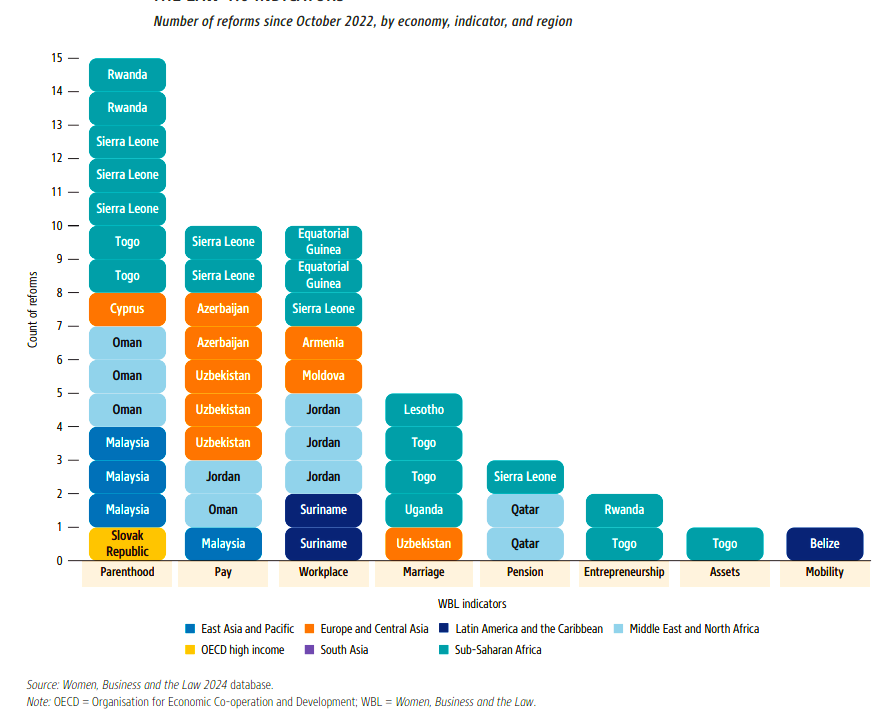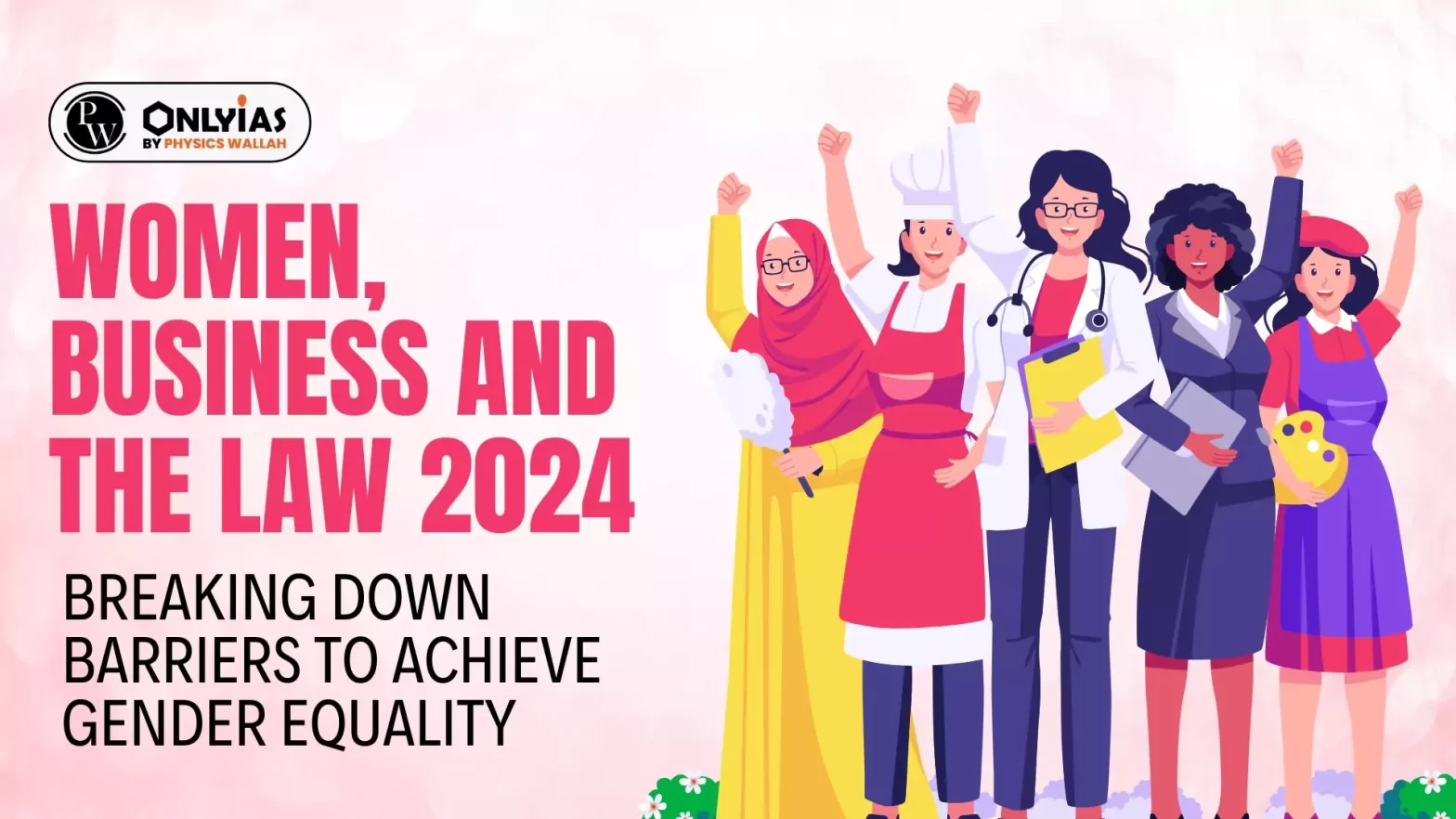Context:
This Article is based on the news “Women, Business and the Law 2024” which was published in the World Bank Group. Recently, the World Bank Group released the “Women, Business and the Law 2024” report.
International Women’s Day
|
About Women, Business and the Law 2024
- An Annual Report: It is the 10th in a series of annual studies measuring the laws that affect women’s economic opportunity in 190 economies.
- Analysis: It presented an in-depth analysis of the challenges obstructing women’s entry into the global workforce, hindering their ability to contribute to prosperity for themselves, their families and their communities.
- Measurements: It introduces new measurements to track global progress toward legal gender equality in 190 economies.
- Indicators: This year, it presents two sets of data: Women, Business and the Law 1.0 and an expanded version, Women, Business and the Law 2.0.
- Women, Business and the Law 1.0:
- It updates its index of eight indicators include Mobility, Workplace, Pay, Marriage, Parenthood, Entrepreneurship, Assets, and Pension,
- Women, Business and the Law 2.0:
- It introduces two new indicators: Safety and Childcare and revises the ongoing indicators.
Key Findings of the Women, Business and the Law 2024- Persistent Global Gaps
-
Weak Legal Rights:
- Worldwide women legal rights are significantly lower than initially perceived.
- When considering legal distinctions related to violence and childcare, women are found to have less than two-thirds or 64% of the rights enjoyed by men.
- Estimation: Earlier estimates projected women had 77% of the rights.
-
Implementation Gap:
- There is a substantial implementation gap, with countries, on average, establishing less than 40% of the required systems for full implementation.
- Example: While 98 economies have enacted laws mandating equal pay for women, fewer than one in five have adopted measures or mechanisms addressing the pay gap.
-
On Legal Equality Opportunity Reforms:
- In 2023, governments made strides in advancing legal equal-opportunity reforms in three categories—pay, parental rights and workplace protections.
- However, the report revealed poor performance in the two new categories being tracked—access to childcare and women’s safety.
-
Poor Performance on Safety & Childcare:
- Nearly all economies performed poorly in the two indicators being tracked for the first time—Safety and Childcare.
- On Women’s Safety: It emerged as a significant weakness, with a global average score of just 36, indicating that women have barely a third of the required legal protections against domestic violence, sexual harassment, child marriage and femicide.
- On Childcare: Only 78 economies provide financial or tax support for parents and just 62 have quality standards for childcare services.

-
Notable Regional Disparities:
- Among the Organisation for Economic Co-operation and Development (OECD) high-income economies, 11 countries score 90 points or above.
- The gap in scores between the highest- and lowest-scoring economies is most pronounced in high-income economies, with a substantial difference of 75 points.
-
Obstacles faced by Women in Other Areas:
- On Entrepreneurship: Globally, only 44% of the legal provisions that support the entrepreneurship of women are in place. Women hold just one out of every five corporate board positions..
- On Pay: Women earn just 77 cents for every dollar paid to men.
- On Nationality Rights: In 28 economies, a woman cannot pass her nationality to children in the same way as a man.
- On Retirement: In 62 economies, the age at which men and women can retire is not the same, with women retiring earlier than men.
- In 81 economies, a woman’s pension benefits do not account for periods of work absences related to childcare.
Crucial Insights of India’s Performance From Women, Business and the Law 2024 Report
-
Improvement in Ranking:
- India’s rank has marginally improved to 113, with a score of 74.4%.
- While the country’s score has remained constant since 2021, its ranking declined from 122 in 2021 to 125 in 2022 and 126 in the 2023 index.
-
Disparity in Legal Rights:
- Indian women have just 60% of the legal rights compared to men, slightly below the global average of 64.2%.
- Best Performer in South Asia: India outperformed its South Asian counterparts, where women have only 45.9% of the legal protections enjoyed by men.
-
On Women’s Pay:
- India receives one of its lowest scores in the indicator evaluating laws impacting women’s pay.
- Possible Solutions: India could explore measures such as mandating equal pay for equivalent work, permitting women to work at night on par with men and enabling women to engage in industrial jobs on an equal footing with men.
-
On Supporting Framework:
- India scored higher than both the global and South Asian averages.
- The lowest indicator in frameworks was childcare.
- Possible Solutions: Creating a publicly accessible registry or database of childcare providers and implementing a well-defined application process for parents seeking government financial support for childcare services, among others.
Status of Women in India
-
Low Literacy Rate:
-
Low Participation in Workforce:
- Only 11.75% of India’s police force is female, and 56.5% of women earning a “regular wage or salary” outside agriculture are not eligible for any social security.
-
Safety Concern:
- Women face various challenges such as foeticides, domestic violence, rape, trafficking, forced prostitution, honour killings, sexual harassment at the workplace, etc.
- In 2024, India’s crime rate stood at 445.9 per 100,000 people.
- It was marking a decline from 487.8 in 2020. However, crimes against women increased by 4%.
-
Period Poverty:
-
Role Stereotyping:
- A large section of the Indian Society considered the roles of men as taking all the financial responsibilities and working outside and women may be considered to be less reliable as workers because of their child-rearing functions.
-
Differentiation in the Socialisation Process:
-
- In many parts of India, especially in rural regions, there are still different socialisation norms for men and women.
- Women are expected to be soft-spoken, calm, and quiet, whereas men ought to be confident, loud, and able to display any behaviour as per their wish.
-
Less Representation in Legislature:
Way Forward to Gender Equity And Equality
-
Emphasize Reforming Laws & Enacting Public Policies:
- Accelerate efforts to reform laws and enact public policies that empower women to work and start a business.
- Improve laws related to women’s safety, access to childcare and business opportunities.
- Establish frameworks that support the effective implementation of laws promoting gender equality.
- Implement legally binding quotas for women on corporate boards and mandate gender-sensitive criteria for public procurement processes.
- Some of the famous women empowerment schemes in India are Beti Bachao Beti Padhao Scheme, Mahila Mandal Scheme, Mahila Shakti Kendras (MSK), Mahila Police Volunteers, Mahila E-Haat, etc.
-
Eliminating Discriminatory Laws & Practices:
- Enact legal reforms that mandate equal pay for work of equal value and lift restrictions on a woman’s ability to work in industrial jobs.
- Expand maternity and paternity leave provisions, and prohibit the firing of pregnant women.
- The Indian Constitution guarantees equal pay for equal work for both men and women under Article 39(d) and Article 42.
- The Indian Constitution also prohibits discrimination on the basis of gender under Article 15(1) and Article 15(2).
-
Provide Financial Support:
- Provide financial support for parents with young children, and establish quality standards for childcare services.
- Ensure equal retirement benefits for women, accounting for periods of work absences related to childcare.
- The Lakhpati Didi Program, implemented by the Ministry of Rural Development, aims to catalyze economic empowerment and financial independence among women in rural areas.
- A Lakhpati Didi is a Self-Help Group member who earns an annual household income of Rupees One Lakh (₹1,00,000) or more.
-
Women’s Workforce for World Economic Growth:
- In an era of persistently slow growth, increasing the participation of women in the global workforce could significantly brighten the outlook.
- Closing the gender gap in employment and entrepreneurship could raise the global gross domestic product by more than 20%.
- Eliminating the gender gap over the next decade would essentially double the current global growth rate.
-
Women’s Safety:
- For Women’s safety, there is a need to introduce more women police forces such as the Nirbhaya Squad, which comprises trained women police officials.
- The Nirbhaya Squad was formed to prevent various crimes perpetrated against women including sexual harassment, stalking, rape and acid attacks among others.
Need to Learn from Other Countries’ Practices:
- Rwanda’s Political Representation: Rwanda’s Constitution, adopted in 2003, mandates that 30% of parliamentary seats be reserved for women.
- Iceland’s Equal Pay Law: Gender-based pay discrimination has been illegal in Iceland since 1961. And in 2018, Iceland adopted a new law that requires companies to demonstrate that their wages are fair in terms of equal value.
- Sweden’s Parental Leave: Sweden provides 480 days of paid parental leave, to be used before a child is eight. Two-parent households get the full benefit only if each parent takes ninety, non-transferable days off, an effort to ensure that no one parent or gender is seen as the sole caregiver.
- Norway’s Board Membership Rule: Since 2008, Norway has required that women make up 40% of publicly listed company boards. Companies that fail to comply risk dissolution.
- The United Kingdom’s National Health Service: The U.K.’s National Health Service covers abortion and treatment for gender dysphoria.
|
Conclusion
The new Women, Business and the Law 2.0 three-tiered approach, reveals important gaps and demonstrates that the perceptions of experts on the status of women’s rights are not always in line with what is needed to implement those rights in practice. Effective implementation of equal-opportunity laws necessitates a robust supporting framework and accessible healthcare services.
Also Read: NCRB Report 2022 On Crime In India
| Prelims PYQ (2017):
Which of the following gives ‘Global Gender Gap Index’ ranking to the countries of the world?
(a) World Economic Forum
(b) UN Human Rights Council
(c) UN Women
(d) World Health Organization
Ans: (a) |
![]() 7 Mar 2024
7 Mar 2024


